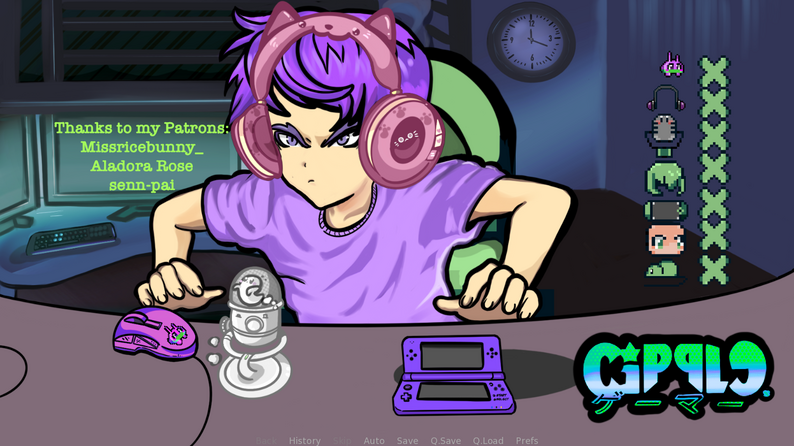
- RENPY PIXEL PICKER HOW TO
- RENPY PIXEL PICKER GENERATOR
- RENPY PIXEL PICKER UPDATE
- RENPY PIXEL PICKER FULL
- RENPY PIXEL PICKER SOFTWARE
RENPY PIXEL PICKER HOW TO
Within this blog I will use the terms “dress-up” and “character generator” interchangeably. The Ren’py documentation does a fine job of defining the specifications of position properties, but intuitively understanding how to use those properties can still be hard because it doesn’t include much in the way of examples or elaboration, so here are some of those. Renpy Tutorial 02: Displaying and Manipulating Images - YouTube 0:00 / 13:05 Intro Renpy Tutorial 02: Displaying and Manipulating Images Elaine 5. Dress-up games and character generators can have some overlap, since character generators can give you clothing options and dress-up games can give you some control on the character’s appearance such as hair color and hairstyle. I would define a dress-up game as a UI which allows you to choose between articles of clothing for a static character. An example of this is South Park’s avatar generator.
RENPY PIXEL PICKER GENERATOR
I would define a character generator as a user interface (UI) which allows you to choose between hairstyles, skin color, eyes, nose, mouth, and other character defining features in order to create a unique character. This tutorial and project are inspired by this article, which explains how to make a dress-up game using JavaScript, HTML, and CSS. If anyone has worked out any improvements => leave a comment.In this tutorial we are making a dress up game (or character generator) using React and Sass. I hereby put all fragments under an GPLv3 license.Īlso feel free to ask questions in the comments if you have trouble understanding my gibberish. Final Wordsįeel free to use any code that I published in this article. Note that there might still be some steps missing, but I hope I covered the most important resolutions. # factor to scale to this resolution => the highest resolution should be # which *should* be recognizable by unusal aspect ratios) set the scale # if the aspect ratio is somewhat reasonable (not some multi-screen setup # find the appropriate scaling factor, 1 being the default # get a list of display modes, sorted by resolution

# Only use the system resolution if it seems to make sense and isn't (currently works only on windows systems) # At first, try to detect the system resolution.

Zacznij od pustego pótna, zdjcia, filmu lub wybierz jeden z naszych profesjonalnie przygotowanych szablonów. Covering popular subjects like HTML, CSS, JavaScript, Python, SQL, Java, and many, many more. Edytuj zdjcia i twórz wspaniae projekty bezporednio w przegldarce, na telefonie lub komputerze za darmo. W3Schools offers free online tutorials, references and exercises in all the major languages of the web. Screen_factor = float(source_x) / float(source_y) Witamy w Pixlr, numerze 1 w narzdziach do edycji i projektowania zdj. Source_factor = float(source_x) / float(source_y) # if the system resolution cannot be found, the ratio of the sourceĭef get_target_resolution(source_x, source_y): Otherwise, you'll have to compile the modules yourself. For changes to Ren'Py that only involve Python modules, you can use the modules found in the latest nightly build. Getting Started Ren'Py depends on a number of Python modules written in Cython and C. # - aspect ratio of the original system resolution Ren'Py development takes place on the master branch, and occasionally on feature branches. # Function for retrieving scaling data for the images.

# get_target_resolution(source_x, source_y) It includes the PNG files and all of the code already programmed into a renpy file (Not Built). I finally came up with the following function which does all this: Finding the best resolution

The tricky part is determining the optimal resolution to use. Image myimage = im.Scale("images/whatever.jpg",, ) The scaling of images itself is easy, just create your image variable in the script using im.Scale() Then find the optimal fullscreen resolution and scale the images and game interface to that size. The basic approach is simple: Create the images in an as high resolution as possible (or reasonable). One little disclaimer: This is the first time that I came in contact with python – the language behind Ren’Py – so my terminology might be awkward.
RENPY PIXEL PICKER UPDATE
Will put the update in when they have got their act together.
RENPY PIXEL PICKER FULL
Unfortunately the engine makers have been unsuccessful in getting full screen to work.
RENPY PIXEL PICKER SOFTWARE
EDIT: Now the software have a fullscreen button that can be added to any project. This article describes how I extended our story with an automatic scaling system. At the moment, the program does not have a fullscreen mode. We stumbled upon a „little problem“: Out of the box, images in Ren’Py can only be of one size, but we wanted to use the maximum possible resolution. Last semester, I was involved in the creation of such a novel („ Felix, Gaijin“ – German only, sorry) together with several fellow students. Ren’Py is an authoring system for visual novels.


 0 kommentar(er)
0 kommentar(er)
